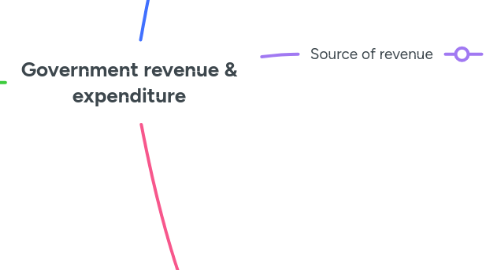
1. Types of government expenditure 1. Operating expenditure → for actual growth 2. Development expenditure → for potential growth
1.1. Operating expenditure - Incurred in day to day routine work - Eg: ministries expenditure on labour (wages), maintenance of equipment, grants-in-aid to statutory boards and aided educational institutions
1.2. development expenditure - Impacts LRAS - Extra expenditure for economic and social development - In anticipation of possible returns in the future - EG. rail projects, public housing subsidies, rental flats
2. - Role of government: Correct market failure by: ● Provision of public & merit goods ● Regulating competition ● Redistributing incomes → maximise welfare - Govt budget must address SG current & future needs, while remaining fiscally sustainable
3. Source of revenue
3.1. 1. NRIC (net investment returns contribution) 2. Taxes (CIT, PIT, GST) 3. Fees & charges (ERP)
3.1.1. NRIC - Returns on our investment on our reserves
3.1.2. Taxes - Compulsory payments to the govt by private individuals & corporations - Govt has to be careful not to discourage investment efforts and incentives
3.1.2.1. Direct taxes - Levied on income/earnings - Paid directly by the taxpayers to the authorities - Burden of the tax cannot be shifted to other people - Impact & incidence of the tax falls directly on taxpayers [Eg. PIT, CIT, capital gains tax, property tax]
3.1.2.1.1. Direct tax - progressive; Rich tends to spend a smaller proportion of their income → Burden of indirect tax on consumption felt more by poor
3.1.2.2. Indirect tax - Levied on expenditure (G&S) - Collected through intermediaries → retailers - Burden of tax can be shifted to another party → extent of tax burden on C&P depends on PED&PES [custom duties, GST]
3.1.2.2.1. Indirect tax - regressive; Rich tends to spend a smaller proportion of their income → Burden of indirect tax on consumption felt more by poor
3.1.2.3. Purpose of taxation 1. Raise revenue → maximise SOL 2. Improve inequality 3. Correct market failure
4. Goals of budget / fiiscal policy 1. Efficiency 2. Equity 3. Economic growth
4.1. Efficiency in resource allocation - Improve efficiency in areas where market is unable to do so - Eg. provision of public goods, subsidizing merit goods, taxing demerit goods
4.2. Sustained economic growth (w low inflation)
4.3. Improve equity - Redistribute income
5. Type of fiscal policy adopted will depend on 1. Current state of the economy 2. Stage of development of economy
5.1. Current state of economy (and its prospects) - Fall in AD → unemployment increase → negative economic growth → govt adopted budget deficit - Requires the govt to balance the budget in the long term → move towards a surplus budget
5.2. Stage of development of economy - Ability of govt to implement expansionary fiscal policy - For LDC with low domestic savings due to high poverty level → govt need to adopt budget deficit to boost capital resources
6. Fiscal policy
6.1. Contractionary (surplus)
6.1.1. - Tax revenue > expenditure - Cut expenditure - Raise tax
6.1.1.1. - Lower AD → reduce DD-pull inflation - Prevent overheating
6.2. Expansionary (deficit)
6.2.1. - Tax revenue < expenditure - Increase expenditure - Cut taxes
6.2.1.1. - Boost economic growth & employment → increase AD - Prevent recession
